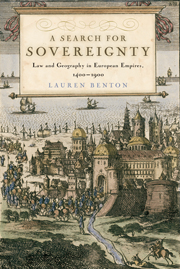6 - Bare Sovereignty and Empire
Published online by Cambridge University Press: 05 June 2014
Summary
We know sovereignty when we see it – at least we think we do. Postnineteenth- century definitions of sovereignty highlight the ambition to control what and who crosses borders as well as the power to make laws to regulate what happens within them. State sovereignty and national sovereignty are terms that have lodged themselves in our political vocabulary to such a degree that they appear to have no logical substitutes. Yet we also know that sovereignty is often more myth than reality, more a story that polities tell about their own power than a definite quality they possess. Most boundaries are porous and many are contested, and states cannot consistently enforce laws to regulate activities across and within borders. And as we have seen, territory plays tricks. Mere patches of regulated land may appear to signify claims to vast holdings, while integral “sovereign” space may fracture into many odd-shaped pieces. The problem is not just that tumultuous times and distant realms produce unmanageable complexity. Political space everywhere generates irregularities: polities and subpolities secure exemptions from legislation, jurisdictions guard their autonomy, and subjects and citizens seek to expand or protect extraterritorial legal rights. Peculiar forms of attenuated and partial sovereignty are as common to political life as acts of corruption, and they are politically more far reaching in their effects.
How do we reconcile these two kinds of knowledge about sovereignty, our certainty about its definition and our recognition of its elusiveness?
- Type
- Chapter
- Information
- A Search for SovereigntyLaw and Geography in European Empires, 1400–1900, pp. 279 - 300Publisher: Cambridge University PressPrint publication year: 2009

